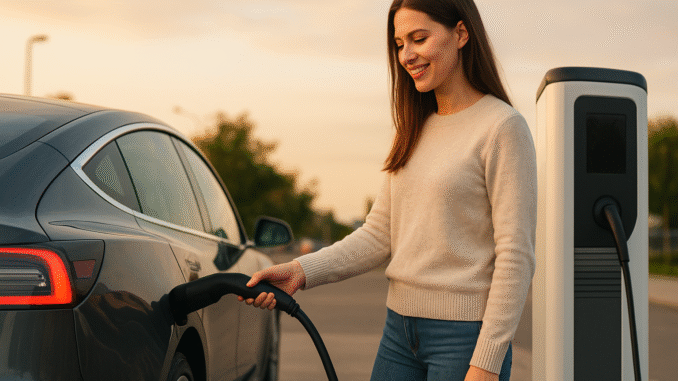
Driving Into the Future: How Electric Vehicles Are Transforming the Automotive Industry
The automotive world is undergoing one of the most revolutionary transformations in its history. From the invention of the internal combustion engine to the rise of automation and now the era of electric mobility, the industry has continuously evolved to meet the changing demands of technology, society, and the environment. Among these changes, the rise of electric vehicles (EVs) stands as one of the most impactful. Electric vehicles are not only reshaping how we drive but also redefining the future of energy, manufacturing, and sustainability.
This article explores how electric vehicles are transforming the automotive industry, the key drivers behind their growth, and what the future holds for this exciting new era of mobility.
1. The Rise of Electric Vehicles: A Shift in Motion
Just a decade ago, electric cars were seen as futuristic and somewhat impractical. High prices, limited driving ranges, and a lack of charging infrastructure made them a niche product for eco-conscious consumers. However, things have changed dramatically in recent years. With technological advancements, growing environmental awareness, and strong government incentives, EVs have entered the mainstream.
According to industry reports, global sales of electric vehicles surpassed 14 million units in 2024, and the number continues to rise rapidly. Countries such as China, the United States, and those in the European Union are leading this shift with major policies aimed at reducing carbon emissions and promoting sustainable transport solutions. As a result, electric cars are no longer just an alternative—they are becoming the standard for the future of mobility.
2. The Technology Behind the Revolution
At the heart of the EV revolution is battery technology. The development of lithium-ion batteries has made electric vehicles more practical, efficient, and affordable. Over the past decade, battery costs have dropped by more than 80%, while energy density has increased significantly. This means electric vehicles can now travel farther on a single charge, sometimes exceeding 500 miles (800 km), depending on the model.
Furthermore, innovations such as solid-state batteries promise to make EVs even better in the coming years. These batteries offer faster charging, longer lifespans, and improved safety compared to traditional lithium-ion technology. Automakers and tech companies around the world are investing billions into developing this next generation of power storage.
In addition to batteries, advancements in electric motors, regenerative braking systems, and lightweight materials have made EVs more efficient than ever. With fewer moving parts and less need for maintenance, electric cars are also proving to be more reliable and cost-effective in the long run.
3. Charging Infrastructure: Powering the Change
One of the major challenges for EV adoption has been charging accessibility. However, this issue is being rapidly addressed with the expansion of charging networks across the globe. Governments and private companies are working together to build fast-charging stations in urban areas, highways, and even remote locations.
Tesla’s Supercharger network, for example, has set the benchmark for fast and convenient charging. Meanwhile, universal charging standards like CCS (Combined Charging System) and CHAdeMO are making it easier for drivers to charge their vehicles anywhere. Moreover, innovations such as wireless charging and solar-powered charging stations are emerging, further enhancing convenience and sustainability.
Home charging is another major advantage of electric vehicles. With a simple wall charger, owners can power their cars overnight—much like charging a smartphone. This convenience makes EV ownership even more appealing to everyday drivers.
4. Environmental Impact: Driving Toward Sustainability
Perhaps the most significant reason behind the push for electric vehicles is their positive environmental impact. Traditional gasoline and diesel vehicles contribute heavily to air pollution and greenhouse gas emissions. Electric vehicles, on the other hand, produce zero tailpipe emissions and have the potential to drastically reduce the carbon footprint of transportation.
When powered by renewable energy sources like solar or wind power, EVs become nearly carbon-neutral. Many countries are integrating EVs into their broader clean energy strategies, using them not only as transportation but also as part of a sustainable energy ecosystem.
Additionally, EV manufacturing processes are becoming more eco-friendly. Automakers are focusing on recycling old batteries, reducing waste, and using sustainable materials in production. The push for circular economy practices ensures that the EV revolution supports a greener, cleaner future.
5. Economic Impact: Creating a New Automotive Landscape
The shift to electric mobility is not just an environmental necessity—it’s also an economic opportunity. The EV industry is creating millions of jobs in manufacturing, software development, energy production, and infrastructure. As demand grows, new businesses are emerging in areas like battery recycling, charging technology, and renewable energy integration.
Traditional automakers such as Ford, General Motors, and Toyota are reinventing their business models to compete with EV pioneers like Tesla, Rivian, and BYD. At the same time, tech companies such as Apple and Google are exploring partnerships to enter the automotive market, blending software innovation with electric mobility.
This new ecosystem is also transforming supply chains. The demand for raw materials like lithium, cobalt, and nickel has surged, encouraging global investment in mining and battery recycling. Governments are supporting domestic production to reduce reliance on imports and strengthen local economies.
6. The Role of Artificial Intelligence and Smart Connectivity
Electric vehicles are not just about replacing engines with batteries—they represent a complete shift toward smart, connected mobility. AI-powered systems are enabling advanced features like autonomous driving, predictive maintenance, and intelligent energy management.
For example, many EVs now come equipped with self-driving capabilities, adaptive cruise control, and lane-assist technologies that improve safety and comfort. Over-the-air (OTA) updates allow manufacturers to continuously improve their vehicles without requiring physical visits to dealerships.
Moreover, EVs are increasingly connected to smart city infrastructure. This means cars can communicate with traffic systems, charge during off-peak hours to save energy, and even supply electricity back to the grid through vehicle-to-grid (V2G) technology. These innovations are turning electric cars into active participants in the global energy ecosystem.
7. Challenges on the Road Ahead
Despite the progress, several challenges remain before electric vehicles can completely dominate the automotive industry. Battery disposal and recycling, raw material shortages, and high upfront costs are still major issues that manufacturers and governments must address.
Range anxiety—fear of running out of battery power—is also a common concern among potential buyers. Although new EVs offer impressive ranges, public awareness and education about charging options remain essential for mass adoption.
Furthermore, developing nations may face difficulties in transitioning to EVs due to limited infrastructure and affordability concerns. Bridging this gap will require international cooperation, technological sharing, and continued innovation.
8. The Future Outlook: A New Era of Mobility
The future of electric vehicles looks incredibly promising. By 2035, many countries plan to phase out the sale of new gasoline and diesel cars entirely. Automakers are racing to electrify their entire lineups, and battery technology continues to improve at an astonishing rate.
We can expect to see affordable EVs with 1,000-mile ranges, faster charging times (under 10 minutes), and smart integration with renewable energy systems. Autonomous electric taxis, shared mobility platforms, and even electric aircraft are on the horizon, redefining what transportation means for future generations.
In this new world, cars will not just be a means of getting from one place to another—they will be intelligent, sustainable, and deeply connected to the energy networks that power our planet.
Conclusion
The electric vehicle revolution is more than a technological shift—it’s a global movement toward sustainability, innovation, and cleaner living. From advanced batteries and AI integration to new business models and environmental benefits, electric vehicles are transforming every aspect of the automotive industry.
As we drive into the future, it’s clear that the road ahead will be electric. The journey may still face challenges, but one thing is certain: the future of mobility will be powered by innovation, driven by sustainability, and defined by electricity.

